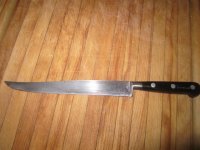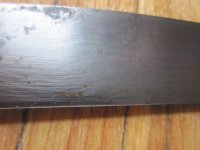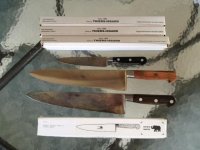The first good knife I ever bought was a Sabatier slicer when I was a young woman, because I heard someone on TV (I think it was Frugal Gourmet) who said to buy knifes with "high carbon steel".
I found this knife in a discount kitchen store for $20. I bought one and my mother bought one.
Somewhere along the line, I lost mine to someone's house. I inherited my mother's Sabatier slicer (Happy Mother's Day, Mom!).
Anyway, my mother's knife was in sad, rusty, gray-spotted shape. I took it, along with some of my Henkel knives, to a professional knife-sharpener, and they did a great job with all the knives. They cleaned up the Sabatier's blade, as well as sharpening it.
But, the Sabatier keeps getting rust spots and gray spots. It doesn't slice any better than my Henkel slicer, and is a pain to keep clean and rust-free.
So, I'm wondering, what is the best way to care for this knife? And is it worth the effort? Why?
The first photo makes it look shinier than it is, since it's reflecting the flash. The second photo shows some of the rust and gray spots that keep cropping up.
Any insights?
TIA!
Lee
I found this knife in a discount kitchen store for $20. I bought one and my mother bought one.
Somewhere along the line, I lost mine to someone's house. I inherited my mother's Sabatier slicer (Happy Mother's Day, Mom!).
Anyway, my mother's knife was in sad, rusty, gray-spotted shape. I took it, along with some of my Henkel knives, to a professional knife-sharpener, and they did a great job with all the knives. They cleaned up the Sabatier's blade, as well as sharpening it.
But, the Sabatier keeps getting rust spots and gray spots. It doesn't slice any better than my Henkel slicer, and is a pain to keep clean and rust-free.
So, I'm wondering, what is the best way to care for this knife? And is it worth the effort? Why?
The first photo makes it look shinier than it is, since it's reflecting the flash. The second photo shows some of the rust and gray spots that keep cropping up.
Any insights?
TIA!
Lee



